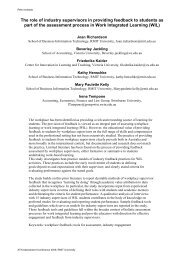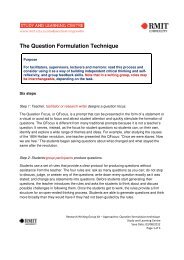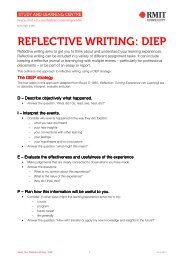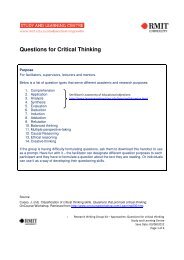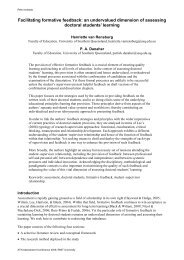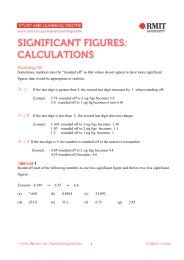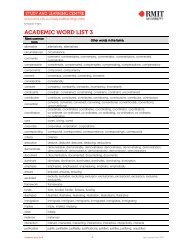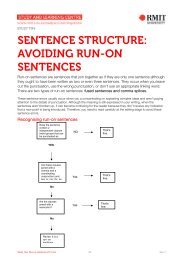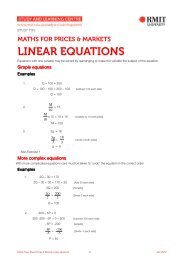student feedback and leadership - Office for Learning and Teaching
student feedback and leadership - Office for Learning and Teaching
student feedback and leadership - Office for Learning and Teaching
You also want an ePaper? Increase the reach of your titles
YUMPU automatically turns print PDFs into web optimized ePapers that Google loves.
Part B: Building Leadership Capacity - BUS: School of Economics, Finance & Marketing ART Report<br />
8.5 Outcomes & Evaluation of Initiatives<br />
What outcomes did the project achieve? Expected <strong>and</strong> unexpected?<br />
Each of the four Common Core Course Coordinators evaluated <strong>and</strong> sought<br />
<strong>feedback</strong> on the developments they had initiated as follows:<br />
Stage 3: Observe <strong>and</strong> Evaluate<br />
Student <strong>feedback</strong> was sought to identify the impact of the changes made<br />
in each of the courses. In addition, staff observed the impact of these changes<br />
on <strong>student</strong>s in class, the type of communications received from <strong>student</strong>s <strong>and</strong><br />
in some cases the impact on <strong>student</strong> results. Each course will be discussed<br />
as follows:<br />
MKTG1025 – Marketing Principles<br />
First Semester 2008<br />
Audience response systems were tested in two lecture times in Marketing<br />
Principles – Class A (n=300) made up of first year school leavers <strong>and</strong> class<br />
B (n=120) predominantly made up of mature age <strong>student</strong>s. A total of 140<br />
<strong>student</strong>s registered <strong>for</strong> the trial, primarily from class B. The system was tested<br />
in five sessions commencing in week four. The in-class participation rate<br />
was disappointingly low. A focus group was conducted part way through<br />
the semester <strong>and</strong> then followed up by an end of semester survey to identify<br />
the reasons <strong>for</strong> this low uptake, particularly in class A.<br />
There were many reasons <strong>for</strong> lack of participation, but predominantly it was<br />
the cost, or perceived cost, associated with using the mobile phones. Many<br />
<strong>student</strong>s in class A had low value mobile phone plans which did not allow<br />
them to connect to the internet, restricted their access to the provider’s<br />
website, or charged them a premium to use the internet facility. Also, a majority<br />
of the <strong>student</strong>s from this class had never used the internet function on their<br />
mobile phones <strong>and</strong> were uncertain as to exactly how much it was going<br />
to cost them. The mature age <strong>student</strong>s who had a low cost data package<br />
or had employers pay <strong>for</strong> their mobile use were most willing <strong>and</strong> enthusiastic<br />
in their participation in the trials.<br />
In general, <strong>student</strong>s had a favourable attitude towards the use of this<br />
technology <strong>and</strong> indicated they would prefer a class where this technology<br />
was used over one that did not, provided it was made available free of cost.<br />
Both classes indicated that such initiatives would help them in their learning<br />
process. Class A, which had the lowest participation rate, also had a less<br />
positive attitude towards the use of technology, compared to class B which<br />
participated more actively. Class B saw benefits of this technology, but<br />
did not wish to see the expansion of such technologies to take over<br />
conventional teaching.<br />
Page 101



